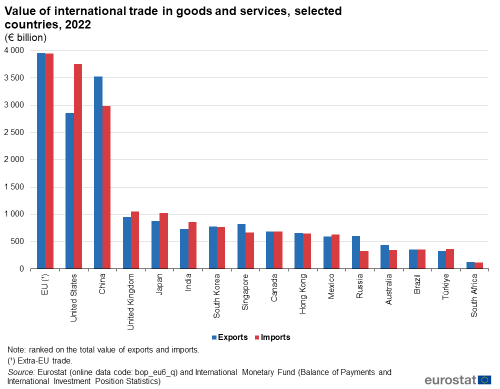
World exports of goods and services
World exports of goods and services (excluding intra-EU trade) increased from €15.9 trillion in 2020 (when it was particularly low due to the impact of the COVID-19 crisis) to €19.1 trillion in 2021
In 2019, the global value of exports of goods and services peaked at €18.1 trillion (or €18 100 billion). The impact of the COVID-19 crisis was apparent insofar as world exports of goods and services fell to €15.9 trillion in 2020 (down 12.1 % in current price terms). In 2021, exports rebounded, up 20.1 % to €19.1 trillion.
Trade levels continued to expand in 2022, although data for the whole world are (at the time of writing) not available. Fresher data are however available for the EU and for many individual countries. Figure 1 shows that the highest levels of trade in goods and services were recorded, unsurprisingly, in some of the biggest economies. The EU exported more goods and services in 2022 (€3.96 trillion) than any individual country and the EU also recorded the highest level of imports (€3.95 trillion), just ahead of the United States (€3.76 trillion).
The largest trade surplus for international trade in goods and services – as measured by the difference between exports and imports – was recorded in China (€547 billion in 2022), followed at some distance by Russia (€271 billion). By contrast, the largest deficit was registered in the United States (€898 billion); its deficit was substantially larger than in any of the other main global economies, as it was followed by Japan (€151 billion), India (€129 billion) and the United Kingdom (€106 billion).

(€ billion)
Source: Eurostat (bop_eu6_q) and International Monetary Fund (Balance of Payments and International Investment Position Statistics)
Ratio of trade in goods and services relative to GDP
In 2022, international trade in goods and services represented 25.0 % of the EU’s GDP…
The information presented in Figure 2 shows that – between some of the world’s largest trading countries – the importance of international trade in goods and services was quite different when compared with economic output as measured by gross domestic product (GDP). The ratio presented in Figure 2 is based on the average value of exports and imports relative to GDP and provides a means for analysing the ‘depth’ of globalisation or the ‘openness’ of individual economies.
Increased trade liberalisation from the 1990s onwards provided a stimulus for international trade in goods and services. Within the EU, the ratio of international trade in goods and services relative to GDP rose from 20.3 % in 2012 to 25.0 % by 2022, confirming that trade in goods and services was growing at a faster pace than the overall EU economy. This relative shift may, at least in part, be attributed to the growing importance of trade in intermediate goods, which itself was driven by higher levels of international outsourcing as global production chains were established.
The information presented is also impacted by the COVID-19 crisis and a slowdown in global trade flows during 2020 and the ongoing period of relatively high inflation. Data for the EU provide evidence as to the impact of the pandemic and price rises, in particular for imported energy products. The ratio of international trade in goods and services relative to GDP peaked at 21.8 % in 2019, fell to 20.2 % in 2020, before subsequently rebounding to 21.5 % in 2021 and then accelerating to 25.0 % in 2022.
… while
SDGs, Targets, and Indicators
SDGs, Targets, and Indicators
-
SDG 8: Decent Work and Economic Growth
- Target 8.1: Sustain per capita economic growth in accordance with national circumstances and, in particular, at least 7% gross domestic product growth per annum in the least developed countries
- Indicator: Gross domestic product (GDP) growth rate
-
SDG 9: Industry, Innovation, and Infrastructure
- Target 9.2: Promote inclusive and sustainable industrialization and, by 2030, significantly raise industry’s share of employment and gross domestic product, in line with national circumstances, and double its share in least developed countries
- Indicator: Industry’s share of employment and GDP
-
SDG 12: Responsible Consumption and Production
- Target 12.2: By 2030, achieve the sustainable management and efficient use of natural resources
- Indicator: Domestic material consumption per capita
-
SDG 17: Partnerships for the Goals
- Target 17.11: Significantly increase the exports of developing countries, in particular with a view to doubling the least developed countries’ share of global exports by 2020
- Indicator: Exports of goods and services as a percentage of GDP
| SDGs | Targets | Indicators |
|---|---|---|
| SDG 8: Decent Work and Economic Growth | Target 8.1: Sustain per capita economic growth in accordance with national circumstances and, in particular, at least 7% gross domestic product growth per annum in the least developed countries | Gross domestic product (GDP) growth rate |
| SDG 9: Industry, Innovation, and Infrastructure | Target 9.2: Promote inclusive and sustainable industrialization and, by 2030, significantly raise industry’s share of employment and gross domestic product, in line with national circumstances, and double its share in least developed countries | Industry’s share of employment and GDP |
| SDG 12: Responsible Consumption and Production | Target 12.2: By 2030, achieve the sustainable management and efficient use of natural resources | Domestic material consumption per capita |
| SDG 17: Partnerships for the Goals | Target 17.11: Significantly increase the exports of developing countries, in particular with a view to doubling the least developed countries’ share of global exports by 2020 | Exports of goods and services as a percentage of GDP |
Behold! This splendid article springs forth from the wellspring of knowledge, shaped by a wondrous proprietary AI technology that delved into a vast ocean of data, illuminating the path towards the Sustainable Development Goals. Remember that all rights are reserved by SDG Investors LLC, empowering us to champion progress together.
Source: ec.europa.eu

Join us, as fellow seekers of change, on a transformative journey at https://sdgtalks.ai/welcome, where you can become a member and actively contribute to shaping a brighter future.






